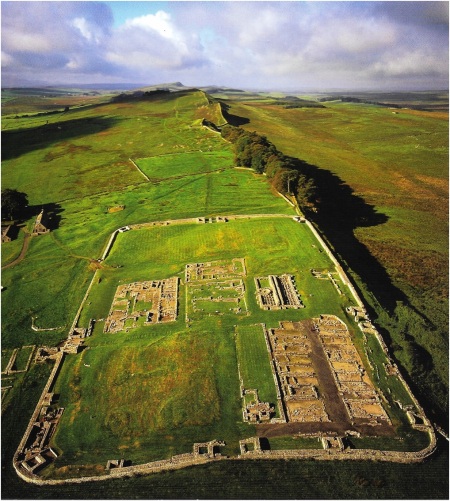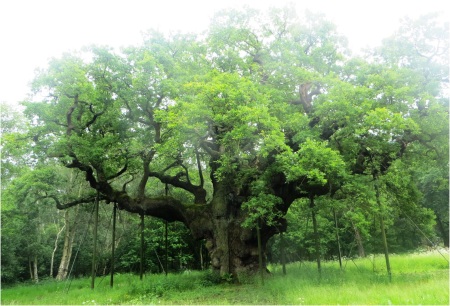For our few days in the caravan at Whitley Bay we didn’t do a great deal that was different from our weekend there the previous year, this time we were entertaining family, but one thing that we did do was to visit Hadrian’s Wall.
Although a lot of people think that the Roman Emperor’s Wall marks the border between England and Scotland it never has and never will because it runs a conveniently short distance between Wallsend near the River Tyne in Newcastle and the Solway Firth in Cumbria. When it came down to military expediency the Romans didn’t concern themselves too much about geography. The wall is entirely within England and although it is close to Scotland in the west at its eastern end the wall is fully seventy miles south of the River Tweed.
Hadrian’s Wall was a defensive fortification in the Roman province of Britannia, begun in AD 122 in the reign of the emperor Hadrian and was the northern limit of the Roman Empire, immediately north of which were the lands of the northern Ancient Britons, people so frightening that even the Romans wouldn’t take them on.
It was a very pleasant day for our visit and the sun was shining but I guess this would have been quite a bleak place two thousand years ago. I imagine a legionnaire waiting for details of his posting and hoping to go Spain or France to the warm inviting beaches of the Mediterranean Sea and bit of sunshine would have been bitterly disappointed to discover that he was going to the bitter cold north of England to help build a massive stone wall.
At a length of almost seventy-five miles long it is the largest remaining construction anywhere in the old Roman world and it was started and finished in just about six years which is an impressive rate of progress compared to how long it takes to get anything built these days.
Seventy-five miles sounds like a lot of wall but by way of comparison the Great Wall of China is over thirteen-thousand miles long, Donald Trump’s Mexico wall is approximately two-thousand miles and even in England Offa’s Dyke running between England and Wales was one hundred and fifty miles long stretching from the River Mersey in the North to the River Severn in the South. The Maginot Line in France (a sort of underground wall) was nine hundred and fifty miles long but ultimately completely useless because the French didn’t get to finish it and in 1940 the German Panzer divisions simply went around it on their way to Paris.
The Romans were more clued up than the French it seems and the wall goes all the way from coast to coast. They didn’t leave a gap at one end that the Barbarians could conveniently use to get past.
Hadrian’s Wall was built almost completely of stone with a small castle every mile to act as a watchtower and a large garrison fort every five miles which was manned by a cohort of troops numbering as many as eight-hundred. A cohort is considered to be the equivalent of a modern battalion.
It is possible to visit quite a lot of these old fortress sites and each one claims to be the biggest and the best but we chose Housesteads (maybe called Vercovicium in Roman times, no one really knows) simply because it is owned by the National Trust and being National Trust members we get to go visit for free, well, not really free but you know what I mean.
I didn’t really know what to expect of the wall, when I was a boy I wondered why the Northern Barbarians didn’t just get some ladders and climb over it when no one was looking but here at Housesteads I got to appreciate the massive scale of the thing. The wall was built on a natural hard granite rock escarpment called Whin Sill which rises dramatically and vertically out of the ground. If this wasn’t enough, on the northern side the wall comprised a ditch, then the wall, a military road an earth rampart and then another ditch with adjoining mounds. No Welcome Mats and if anyone was going to get over this wall it was going to take a lot more than a ladder let me tell you!
Once its construction was finished, it is thought to have been covered in plaster and then whitewashed, its shining surface reflected the sunlight and was visible for miles around, an extravagant expression of Roman military might and the border of the Empire.
So we visited the small museum, watched a short video presentation and then wandered around the site and the excavations and then walked the short distance to Sycamore Gap which is a point in the escarpment where glaciers in the Ice Age carved a path through the rock. The place is significant because here grows a sycamore tree which is said to be the most photographed tree in England and was voted English Tree of the Year in 2016.
Oh, I just love the idea that a country that is England has a Tree of the Year competition. It is astonishing that with such busy lives and so many distractions people actually take time out to vote in a Tree of the Year poll. What next? A weed of the year perhaps.
There is more to this tree however. It is also referred to as the Robin Hood Tree, not because it has anything to do with Sherwood Forest and the Major Oak but because a scene from the movie ‘Robin Hood, Prince of Thieves’ was filmed there, the one where he first comes across the villain Guy of Gisborne.
The Major Oak in Sherwood Forest (above) was voted Tree of the Year in 2014. The latest Tree of the Year (2017) is the Gilwell Oak in Epping Forest which has connections with the Boy Scouts and the founder of the movement Robert Baden-Powell. He adopted the towering oak as a symbol for the growth of the scouting movement world-wide.
So, now we have been to Hadrian’s Wall in Northumberland, The Maginot Line in France, The Great Wall of China, back to England and Sherwood Forest in Nottinghamshire and Epping Forest in Essex and once we were through with our visit to Housesteads we returned to the caravan in Whitley Bay.
Click on an image to scroll through the pictures…





















I’m fascinated by Hadrian’s Wall. Thanks for this tour.
LikeLike
The Wall has always interested me, I can’t believe it has taken me so long to get there. Next year we talk about walking the Wall coast to coast.
LikeLike
Interesting history.
. . . don’t let Trump read this . . .
LikeLiked by 1 person
He will be ordering more sand and cement!
LikeLike
I’ve walked the length of it over 4 days with wife and daughter, and cycled the length of it plus the whole Cumbrian coast (Hadrian’s Cycleway) over a day and a half …. alone! Regarding that bloody tree, when we walked it my daughter had one of her university mates with us, plus each carrying a plastic sword. On reaching the tree, you’ve probably guessed, a re-enactment of the damned sword fight from the movie took place. Embarrassing!
LikeLiked by 1 person
I think we will do it next year now that Kim has retired. East to West or West to East, what do you think?
LikeLike
The Cumbrian end is a problem at Solway. I would advise train to Carlisle, transport from Carlisle out to solway and spend a short day walking back to Carlisle. When you finish, you have easy transport from Newcastle. If you have car daily support it hardly matters.
LikeLiked by 1 person
Thanks. We have family in Newcastle so we can be easily rescued in an emergency!
LikeLiked by 1 person
Consider wind direction too!
LikeLiked by 1 person
Good historial description of the year, and, for me, informative about Tree of the Year
LikeLike
I like the Tree of the Year trivia! Thanks for stopping by.
LikeLiked by 1 person
For first year read wall – thinking too fast 🙂
LikeLiked by 1 person
I was going to mention that the Romans did venture much further north and built the Antonine Wall, but you have it on your map anyway. There’s less of that left, but it’s still discernible and there are ruins of a Roman Bathhouse in Bearsden just outside Glasgow. I have toyed in the past with the idea of walking the wall but the weather puts me off! It is my motherland though (born in Haltwhistle, Northumberland). As for the tree, I was involved with the Scottish competition one year. Once you’ve won your home country’s competition you go into the European competition, and I can tell you that if you think it odd that so many British people vote for a tree you ain’t seen nothin’ yet! Our vote was pitiful in comparison (as were the votes for the other U.K. entries). Europeans really love trees!
LikeLike
I did enjoy reading all about the European Tree of the Year poll. No one really knows about the Antonine Wall, everyone has heard of Hadrian. Poor old Antoninus Pius!
LikeLiked by 1 person
Reblogged this on clawingmywayin.
LikeLike
Good god you’re back in England, nearly gave me a heart attack. As a lad I used to roam around Epping Forest and was transformed into one Dick Turpin, who really was a nasty piece of work I later discovered.
I noticed dispersers comment wasn’t in his usual acerbic fashion ; perhaps he saves that for me. Pity I couldn’t comment on his comment, I’d have given him a bucketful for sure. :twisted;
LikeLike
It does seem an insignificant distance, Andrew, but it didn’t need to be any longer, did it? And far more effective than Maginot, as you point out. 🙂 🙂 There is a definite mystique to the place. Did you visit The Sill on your travels? I mean to go there but expect to be underwhelmed. Maybe now school hols are over. 🙂
LikeLike
Didn’t go there Jo, just to the Wall and back in a morning!
LikeLiked by 1 person
Fascinating post. So nice to see what the wall actually looks like. I love a series of mystery novels about a Roman army doctor stationed in Roman Britannia. The author is Ruth Downie. Several of them take place at Roman settlements near the wall during construction.
LikeLike
I’ll look them up. Thanks.
LikeLiked by 1 person
Loved your shot of the sycamore tree. It’s certainly in a picture perfect setting.
LikeLike
Thanks Gunta.
LikeLike
A promenade along the wall. Super idea! Lucky you. It will be interesting to read your post about it.
Probably, posting to England was a punishment in the empire.
LikeLike
Pingback: Cornwall, Value For Money with the National Trust | Have Bag, Will Travel
Pingback: On This Day – Hadrian’s Wall in Northumbria | Have Bag, Will Travel
It’s all quite atmospheric, isn’t it, and quite easy to imagine life there at the time? We keep meaning to explore the full length.
LikeLike
We have said that we would like to do the east west walk when things settle down again.
LikeLiked by 1 person
See you there?
LikeLiked by 1 person
I visited Housesteads 24 years ago and the memory of the visit is still very clear. I love that first photo of yours!
LikeLike
Thanks Clare. Glad that I gave you a memory nudge!
LikeLiked by 1 person
Pingback: A Virtual Ancient City | Have Bag, Will Travel